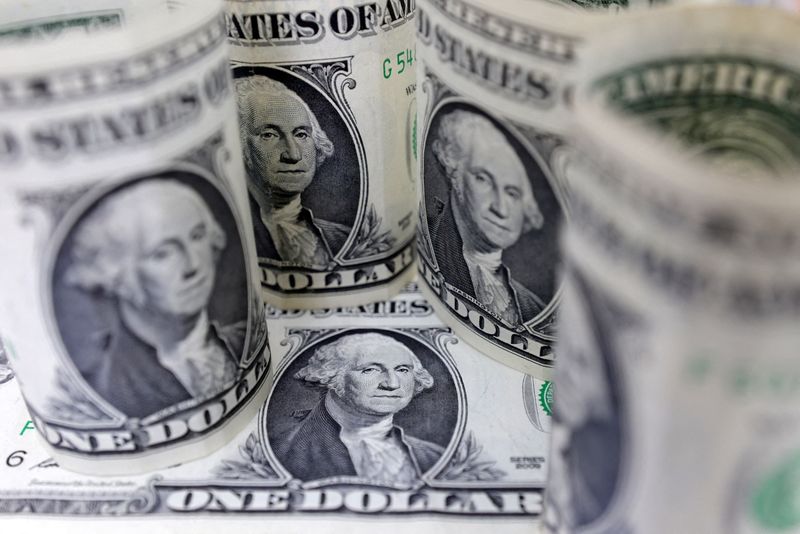By Stefano Rebaudo and Tom Westbrook
SINGAPORE (Reuters) -The dollar hit a one-week low on Thursday as economic data supported expectations for quick rate cuts in the United States, while the battered yen was little changed against other majors.
An unexpected slowdown in U.S. services growth had knocked the dollar lower on Wednesday.
However, for the year so far it remains the best-performing G10 currency as rate cut expectations have been dialled back in the last few months.
Federal Reserve officials, including U.S. central bank chief Jerome Powell, on Wednesday continued to focus on the need for more debate and data before interest rates are cut, a move financial markets expect to occur in June.
The U.S. dollar index, which measures the U.S. currency against six rivals, was down 0.15% at 104.08 after hitting 104.05, its lowest level since March 26.
It is up 2.7% this year as market expectations for some 150 basis points of 2024 rate cuts have been sliced in half.
"(Fed Chair Jerome) Powell was dovish as he repeated expectations that the Fed will cut this year," said Athanasios Vamvakidis, head of global forex strategy at Bofa, adding that Powell's remarks and the ISM data triggered the dollar's fall.
"The market was a bit too bullish (on the dollar) considering the rate cut outlook markets priced in, because several investors got long in the greenback," he added.
The major focus for the rest of the week will be on U.S. labour data due on Friday.
"Looking ahead, today's data calendar is light. The focus will just be on the weekly initial jobless claims data, and these have been wedded to the 210k area for months," said Chris Turner, head of forex strategy at ING.
Futures pricing for a Fed cut in June was broadly steady and implied markets see about a 60% probability of such a move.
The Swiss franc dropped around 0.6% against the euro and the dollar after data showed that the consumer price index rose by a lower-than-expected 1.0% from a year ago in March.
On Thursday it hit its lowest since early May 2023 against the euro at 0.9847 and on the previous day its lowest since early November 2023 versus the greenback at 0.9095.
Analysts said the further fall in Swiss inflation in March reinforced the view that the Swiss National Bank would cut rates by an additional 50 basis points this year.
The yen was close to its 34-year low versus the greenback as the Bank of Japan's historic policy shift to end eight years of negative interest rates failed to bolster the currency.
The rates picture, with U.S. 10-year yields at over 4% and the yen’s still close to zero, is keeping big Japanese investors' cash abroad, where it can earn better returns, depriving the yen of support from repatriation flows.
It was almost flat at 151.76 versus the dollar, after hitting 151.975 last week.
Analysts said the yen was supported by the threat of official intervention.
"The markets expects at least a verbal intervention from the BoJ at 152," BofA's Vamvakidis added. "If they don’t do anything, the dollar-yen will attract speculative flows which will lower the Japanese currency further."
Japanese authorities will likely intervene in the currency market if the yen breaks out of a range it has been in for years and falls well below 152 per dollar, former top currency diplomat Tatsuo Yamazaki said on Thursday.
The euro, up 0.6% on Wednesday, was up a further 0.2% on Thursday and back to the middle of a range it has kept for a year at $1.086.
European inflation came in softer-than-expected on Wednesday, reinforcing expectations for a European rate cut in June.
Traders gave a leg up to the Australian and New Zealand dollars in response, sending the Aussie above its 200-day moving average and to a two-week high of $0.6587.
The Aussie hit a five-month high on the New Zealand dollar with traders expecting New Zealand rate cuts beginning in August but Australian rates on hold until November. [AUD/]

The New Zealand dollar has regained a foothold above $0.60 and was last trading 0.6% firmer at $0.6040.
Chinese markets were closed for a holiday.